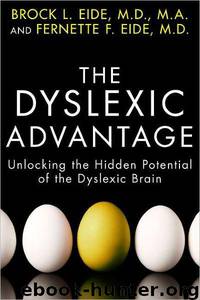The Dyslexic Advantage: Unlocking the Hidden Potential of the Dyslexic Brain by Brock L. Eide; Fernette Eide

Author:Brock L. Eide; Fernette Eide
Language: eng
Format: mobi
Tags: Non-fiction
ISBN: 9781594630798
Publisher: Penguin Group USA
Published: 2011-08-18T00:00:00+00:00
CHAPTER 21
The Advantages of D-Strengths
The first time we spoke with Sarah she quickly informed us, “I’m going to tell you everything as a story, because that’s how I experience the world.” The conversation that followed proved this assertion to be entirely true.
It’s not surprising that Sarah has a highly narrative memory and reasoning style. As we discussed in part 5, many individuals with dyslexia do, and Sarah displays many of the features commonly seen in such individuals. For example, Sarah is a classic “family historian with a poor memory.” As she told us, “I’m the family elephant: all my cousins come to me when they want to find out what happened when and where.” Sarah also struggles with rote memory, which is common for individuals with dyslexia with this pattern: “I have no rote memory at all. I can only remember things if they fit into a structure.” Typically, this structure is a story: “Stories are what I remember—they stick in my memory.”
In fact, narrative is more than a reasoning style for Sarah. It’s also a second career. Sarah Andrews is the author of ten highly regarded mystery novels that feature the exploits of professional geologist and amateur detective Em Hansen. In these novels, Em uses her skills as a geologist—and her prodigious powers of episodic simulation—to solve mysteries.
But the first problem Em solved was one of Sarah’s. Sarah told us, “When I was in my thirties and working in the high-stress atmosphere of the oil business, I had trouble settling down to do my geology work if I’d witnessed an event that had a strong story to it. But I discovered that if I went ahead and wrote down the story or anecdote . . . I could squeegee it out of my mind and focus on the work I was supposed to be doing. Writing just seems to get the stories out of me.”
Sarah described the mental mechanism she uses to construct her stories in a way that closely mirrors our description of episodic construction: “As time passed, the anecdotes gathered like lint in my mind, so I made fabric from it, and the bits of fabric needed to be rearranged in order to move tensions and troubles toward resolution. . . . [This fabric formed] a patchwork quilt of memories, in which I took various events and reorganized them into new events.”
Sarah soon realized that before she could turn these “patchworks” into novels, she needed to figure out how to explain to nongeologists what geologists do and how they think; but before she could do that, she had to explain those things to herself. This preparation required two solid years of introspection, but it was worth the effort because it enabled Sarah to describe geology in all its complexity and wonder in a way that her readers could understand. It also led to many deep insights about “geological reasoning,” which Sarah has described in several fascinating essays. One of these insights concerns the narrative nature of geology.
Download
This site does not store any files on its server. We only index and link to content provided by other sites. Please contact the content providers to delete copyright contents if any and email us, we'll remove relevant links or contents immediately.
Rewire Your Anxious Brain by Catherine M. Pittman(17585)
Talking to Strangers by Malcolm Gladwell(11875)
The Art of Thinking Clearly by Rolf Dobelli(8841)
Mindhunter: Inside the FBI's Elite Serial Crime Unit by John E. Douglas & Mark Olshaker(7833)
Becoming Supernatural by Dr. Joe Dispenza(7103)
Change Your Questions, Change Your Life by Marilee Adams(6639)
Nudge - Improving Decisions about Health, Wealth, and Happiness by Thaler Sunstein(6633)
The Road Less Traveled by M. Scott Peck(6633)
The Lost Art of Listening by Michael P. Nichols(6469)
Enlightenment Now: The Case for Reason, Science, Humanism, and Progress by Steven Pinker(6405)
Win Bigly by Scott Adams(6310)
Mastermind: How to Think Like Sherlock Holmes by Maria Konnikova(6234)
The Way of Zen by Alan W. Watts(5798)
Daring Greatly by Brene Brown(5639)
Grit by Angela Duckworth(4735)
Big Magic: Creative Living Beyond Fear by Elizabeth Gilbert(4723)
Men In Love by Nancy Friday(4319)
Flow by Mihaly Csikszentmihalyi(4051)
The Four Tendencies by Gretchen Rubin(4024)
